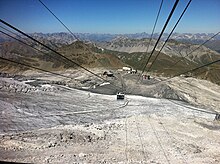Funifor
A Funifor is an aerial cableway with paired parallel supporting cables , the distance between which is approximately equal to or greater than the width of the cable car cabins. The wide cable track has the advantage that the cabin (initially - until 2017 - Funifor lifts with one cabin were built as single-lane pendulum cable cars) e.g. B. can be less stimulated by the wind to swing crosswise.
In contrast to the somewhat older Funitel , the suspension ropes are fixed and the cabin is pulled by pull ropes .
A so-called three - cable gondola ( 3S gondola ) also has two fixed parallel suspension ropes . The purpose of the two suspension ropes is less to improve wind stability than to carry the traction rope (the third of the three ropes) between them on rollers.
Condition and function
Outwardly similar to the Funitel system, which runs on a double hoisting cable loop at a vehicle- wide distance (which is, however, a detachable circulating cable car ), the Funifor is based on two suspension cables, the track of which is also wider than the cabin.
One strand of the pull rope, which is an endlessly spliced loop, runs vertically under the two carrying ropes . The connection between the rope loops coming from above and below and the vehicle is made by means of two horizontally mounted compensating pulleys on the drive, which first divert the pull rope to the opposite side of the cabin and then back to the station. The towing cables run from the top (mountain) side of the vehicle to the mountain station, where they are diverted and guided above the suspension cables on portal-shaped cable riders as slack runs into the valley station, where they run over a tensioning device and again below the suspension cable level back to the valley side of the vehicle . The compensating sheaves on the vehicle, over which the pulling cord loops are guided, do not usually have to cope with a relative speed, but are used to compensate for length and to compensate for any speed differences between the two strands. Both strands wrap around a drive drum. The endless pulling rope loop means that no clamping or potting connections are necessary, and the entire rope loop can be easily moved in order to subject it to a magnetic induction test over the entire length .
The Cabrio , which opened in 2012, is a "real" two-lane aerial tramway with two vehicles running in opposite directions, in which the Funifor feature of the wide double lane (in this case five meters) is used on two suspension cables and the pull rope loop (in this case two) -Bahn on the Stanserhorn . The two-story “convertible” gondolas in this system hang within the suspension and pulling cables that run past to the side.
Manufacturer
Funifor was developed by Erwin Oberhuber in the former Hölzl Seilbahnbau company and the patent was also taken over by Doppelmayr in 2002 through the merger with Doppelmayr .
Investments
The first FUNIFOR " Trincerone - Livrio " (70 people) was built under the name of the Hölzl company in 2000 on the Stilfserjoch . Other single-track funifors are:
- Pianalunga - Passo dei Salati ( Alagna ), 100 people, 2004, ITA
- Arabba - Portavescovo , 80 people, 2005, ITA
- Valcalda - Monte Zoncolan , 100 people, 2007, ITA
- Passo dei Salati - Indren , 60 people, 2009, ITA
- Rifugio Gilberti - Sella Golovec (Prevala), 100 people, 2009, ITA
- Bezau , 60 people, 2010, AUT (single lane)
- Tarlenta - Rifugio Mantova (Pejo), 100 people, 2010, ITA
- Alba - Col dei Rossi , 100 people, 2015, ITA
Web links
- Explanation of the Funifor principle in the cable car dictionary at bergbahnen.org
- German-language website of the manufacturer
- Explanation of the difference between Funitel and Funifor
Individual evidence
- ↑ Technical description of the convertible train at Seilbahn.net , accessed on July 22, 2012.



